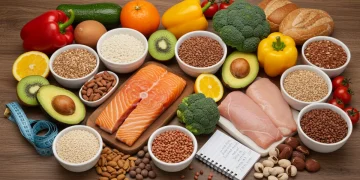Sustainable Eating in the US: Health, Planet, and Your Wallet

Sustainable eating in the US involves making nutritional choices that positively impact both individual health and environmental well-being, often leading to significant financial savings through practical solutions and mindful consumption habits.
Embracing sustainable eating in the US is more than just a dietary trend; it’s a powerful commitment to your health, the planet’s future, and surprisingly, your financial well-being. This guide explores eight nutritional choices that offer practical solutions for a greener, healthier, and more economical lifestyle.
Understanding sustainable eating and its impact
Sustainable eating refers to dietary patterns that promote health and well-being, have low environmental impact, respect biodiversity, and are culturally acceptable, accessible, economically fair, and nutritionally adequate. In the US, our food system contributes significantly to greenhouse gas emissions, water pollution, and land degradation.
The choices we make at the grocery store and in our kitchens have far-reaching effects. Opting for sustainable foods can reduce your carbon footprint, conserve natural resources, and support local economies. Moreover, many sustainable food choices are inherently healthier, focusing on whole, unprocessed ingredients that are rich in nutrients and free from harmful additives.
The environmental costs of conventional food systems
Our current food production methods often rely on intensive farming practices that deplete soil nutrients, demand excessive water, and generate substantial waste. The transportation of food across long distances further exacerbates these issues, contributing to air pollution and energy consumption.
- High greenhouse gas emissions from livestock and agriculture.
- Extensive water usage for irrigation and processing.
- Significant land degradation due to monoculture and pesticide use.
- Pollution from fertilizers and pesticides affecting waterways.
Transitioning to sustainable eating patterns can mitigate these environmental burdens, fostering a food system that is resilient and regenerative. It’s about recognizing that every meal is an opportunity to make a positive impact.
Prioritizing plant-based foods for health and planet
One of the most impactful shifts towards sustainable eating is increasing your intake of plant-based foods. This doesn’t necessarily mean becoming a vegan or vegetarian overnight, but rather incorporating more fruits, vegetables, legumes, and whole grains into your diet. Plant-based diets are consistently linked to a lower risk of chronic diseases, including heart disease, type 2 diabetes, and certain cancers.
Beyond personal health, plant-based diets have a significantly smaller environmental footprint compared to diets rich in animal products. Livestock farming is a major contributor to greenhouse gas emissions, deforestation, and water pollution. By reducing your reliance on meat and dairy, you can dramatically lessen your impact on the planet.
Financial benefits of plant-centric meals
Many people assume that plant-based eating is expensive, but the opposite is often true. Staples like beans, lentils, rice, and seasonal vegetables are typically far more affordable than meat and processed foods. Learning to cook with these ingredients can lead to substantial savings on your grocery bill.
- Legumes and grains are inexpensive and nutrient-dense.
- Seasonal produce is often cheaper and fresher.
- Reduced spending on costly meat and dairy alternatives.
Embracing plant-based meals can also encourage culinary creativity, leading to a wider variety of delicious and healthy dishes. It’s a win-win for your body, your budget, and the Earth.
Choosing local and seasonal produce
Opting for local and seasonal produce is a cornerstone of sustainable eating in the US. When you buy food grown close to home and in its natural season, you support local farmers, reduce the environmental impact of transportation, and enjoy fresher, more nutritious food. Food that travels long distances often requires refrigeration and special packaging, increasing its carbon footprint.
Seasonal produce also tends to be at its peak flavor and nutritional value, as it’s harvested when ripe. It’s often cheaper too, as local supply is abundant, and distribution costs are minimized. Farmers’ markets are excellent places to find local and seasonal items, fostering a direct connection between consumers and producers.

Supporting local agriculture helps preserve farmland, protects biodiversity, and strengthens community food systems. It allows you to know where your food comes from and how it was grown, building trust and transparency.
Finding local food sources
Locating local and seasonal produce is easier than you might think. Beyond farmers’ markets, many grocery stores now feature local sections, and community-supported agriculture (CSA) programs deliver fresh produce directly from farms to your doorstep. Online directories can also help you find nearby farms and vendors.
- Visit local farmers’ markets for direct farm-to-consumer purchases.
- Join a CSA (Community Supported Agriculture) program.
- Look for ‘local’ labels in grocery stores.
By making a conscious effort to choose local and seasonal foods, you contribute to a more resilient and environmentally friendly food system while enjoying superior taste and nutrition.
Reducing food waste at home
Food waste is a significant problem in the US, with an estimated 30-40% of the food supply going uneaten. This waste not only represents a loss of resources used to produce the food but also contributes to greenhouse gas emissions when organic matter decomposes in landfills. Reducing food waste at home is one of the most impactful actions you can take for sustainable eating.
It starts with mindful shopping: planning meals, making a list, and avoiding impulse buys. Proper storage of food can also extend its shelf life, preventing spoilage. Learning to use leftovers creatively and understanding expiration dates versus ‘best by’ dates can further minimize waste.
Practical strategies for minimizing waste
Embracing a ‘root-to-stem’ or ‘nose-to-tail’ philosophy means utilizing all edible parts of food. Vegetable scraps can be used for broths, fruit peels for infusions, and stale bread for croutons. Composting food scraps is another effective way to divert organic waste from landfills and enrich your garden soil.
- Plan meals and create shopping lists to avoid overbuying.
- Store food properly to maximize freshness.
- Use leftovers creatively; don’t let food go to waste.
- Compost fruit and vegetable scraps.
By adopting these simple habits, you can significantly reduce your household’s food waste, saving money and lessening your environmental impact.
Making informed choices about seafood
Seafood can be a nutritious part of a sustainable diet, but it requires careful consideration due to issues like overfishing, bycatch, and destructive fishing practices. Making informed choices means selecting seafood that is caught or farmed responsibly, minimizing harm to marine ecosystems.
Organizations like the Monterey Bay Aquarium Seafood Watch program provide excellent guides on which seafood options are ‘best choices,’ ‘good alternatives,’ or ‘avoid.’ These recommendations are based on scientific assessments of fishing methods, stock levels, and environmental impacts. Opting for sustainably sourced seafood helps protect ocean health and ensures future fish populations.

Beyond environmental concerns, choosing certain types of fish can also have financial implications. Less common, sustainably caught species might be more affordable than popular, often overfished varieties. Exploring new types of seafood can broaden your culinary horizons while supporting responsible fishing.
Understanding sustainable seafood labels
Look for certifications such as the Marine Stewardship Council (MSC) label for wild-caught fish or the Aquaculture Stewardship Council (ASC) label for farmed fish. These labels indicate that the seafood meets rigorous standards for sustainability.
- Consult organizations like Seafood Watch for updated recommendations.
- Look for MSC or ASC certifications on seafood products.
- Choose smaller, less popular species that are more abundant.
By being a conscious consumer of seafood, you play a vital role in preserving marine biodiversity and promoting healthier oceans for generations to come.
Embracing whole grains and legumes
Whole grains and legumes are powerhouses of nutrition and sustainability. They are rich in fiber, protein, vitamins, and minerals, providing sustained energy and contributing to a healthy digestive system. Nutritionally, they are superior to refined grains, which are stripped of essential nutrients during processing.
From an environmental perspective, whole grains and legumes generally require less water and fewer pesticides to grow compared to other crops. Legumes, in particular, have the unique ability to fix nitrogen in the soil, reducing the need for synthetic nitrogen fertilizers, which are energy-intensive to produce and contribute to greenhouse gas emissions.
The economic advantages of whole grains and legumes
Incorporating more whole grains and legumes into your diet is also incredibly budget-friendly. Foods like brown rice, quinoa, oats, lentils, and chickpeas are inexpensive, especially when bought in bulk. They are versatile ingredients that can form the basis of countless delicious and filling meals, significantly reducing overall food costs.
- Whole grains and legumes are highly nutritious and affordable.
- They require less water and fewer pesticides to grow.
- Legumes naturally enrich soil, reducing the need for synthetic fertilizers.
By making these staples a regular part of your diet, you support sustainable agriculture, enhance your nutritional intake, and save money, demonstrating that healthy and eco-friendly eating can be accessible to everyone.
Supporting regenerative agriculture
Regenerative agriculture is a holistic approach to farming that aims to improve soil health, biodiversity, and water quality, while also sequestering carbon from the atmosphere. It goes beyond merely sustaining current practices and actively works to restore ecosystems. This contrasts sharply with conventional agriculture, which often depletes natural resources.
Practices in regenerative agriculture include no-till farming, cover cropping, crop rotation, and rotational grazing. These methods enhance the soil’s ability to hold water, increase its organic matter, and support a diverse microbial community, making farms more resilient to climate change and reducing the need for synthetic inputs.
The benefits for health and environment
Foods grown in healthy, nutrient-rich soil tend to be more nutrient-dense themselves. By supporting farmers who practice regenerative agriculture, you are contributing to a food system that produces healthier food, protects the environment, and combats climate change. While these products might sometimes carry a slightly higher price tag due to the labor-intensive methods, the long-term environmental and health benefits are invaluable.
- Improves soil health and increases biodiversity.
- Sequester carbon, helping to mitigate climate change.
- Reduces reliance on synthetic fertilizers and pesticides.
Seeking out products from farms that employ regenerative practices is a powerful way to vote with your fork, promoting a more sustainable and equitable food future.
Reducing packaging and choosing reusable options
The environmental impact of our food choices extends beyond what we eat to how it’s packaged. Single-use plastics and excessive packaging contribute significantly to landfill waste and pollution. Embracing a low-waste approach to food shopping is a crucial component of sustainable eating in the US.
This involves bringing reusable bags to the grocery store, opting for products with minimal or recyclable packaging, and choosing bulk items when possible. Many stores now offer bulk sections where you can fill your own containers with grains, nuts, seeds, and even liquids, significantly reducing waste.
Financial and environmental advantages
While the initial investment in reusable containers might seem like an added cost, it often leads to long-term savings by allowing you to buy in bulk, which is typically cheaper per unit. Furthermore, reducing packaging waste lessens the burden on waste management systems and minimizes environmental pollution.
- Bring reusable bags and containers when shopping.
- Choose products with minimal, recyclable, or compostable packaging.
- Buy in bulk to reduce individual packaging waste.
By making conscious choices about packaging, you contribute to a cleaner planet and often find more economical ways to shop for your food, aligning your values with your daily habits.
| Key Sustainable Practice | Benefit Summary |
|---|---|
| Embrace Plant-Based Meals | Reduces environmental impact, improves health, and can be more cost-effective than meat-heavy diets. |
| Choose Local & Seasonal | Supports local economies, reduces transportation emissions, and provides fresher, nutrient-dense food. |
| Reduce Food Waste | Saves money, conserves resources, and lessens landfill burden and greenhouse gas emissions. |
| Support Regenerative Agriculture | Improves soil health, sequesters carbon, and produces more nutrient-dense food for long-term ecological benefits. |
Frequently asked questions about sustainable eating
Sustainable eating involves choosing foods that are healthy for you and the planet, like locally grown produce and plant-based options. It’s crucial in the US to reduce our food system’s significant environmental footprint, including emissions and resource depletion, while also improving public health outcomes.
Absolutely. Focusing on plant-based staples like beans and lentils, buying seasonal produce, and reducing food waste are all financially beneficial strategies. These choices often cost less than meat, processed foods, and reduce unnecessary purchases, leading to significant grocery savings over time.
You can find local and seasonal food at farmers’ markets, through Community Supported Agriculture (CSA) programs, or by looking for ‘local’ labels in your grocery store. Online search tools and local farm directories can also guide you to nearby producers, ensuring freshness and supporting your community.
Reducing food waste helps save money by making the most of your purchases. Environmentally, it conserves resources used in food production and reduces methane emissions from landfills, which contribute to climate change. It’s a simple, impactful step for both your wallet and the planet.
Yes, choosing sustainable seafood significantly benefits marine ecosystems. It helps prevent overfishing, reduces bycatch of non-target species, and supports fishing methods that minimize habitat destruction. Look for certifications like MSC or ASC to guide your choices and ensure you’re making an environmentally responsible decision.
Conclusion
Embracing sustainable eating in the US is a powerful journey that aligns personal health with planetary well-being and financial prudence. By making conscious choices about what we eat, where it comes from, and how we consume it, we can collectively foster a more resilient, equitable, and nourishing food system. From prioritizing plant-based meals and local produce to reducing waste and supporting regenerative agriculture, every decision contributes to a healthier future for ourselves and the generations to come. It’s about understanding the interconnectedness of our food choices and their profound impact, transforming daily meals into acts of environmental stewardship and personal empowerment.





